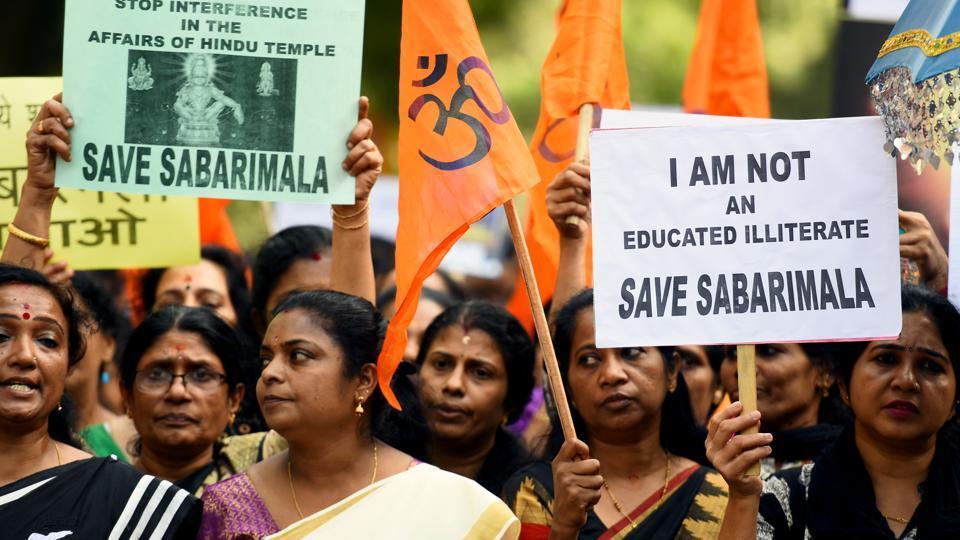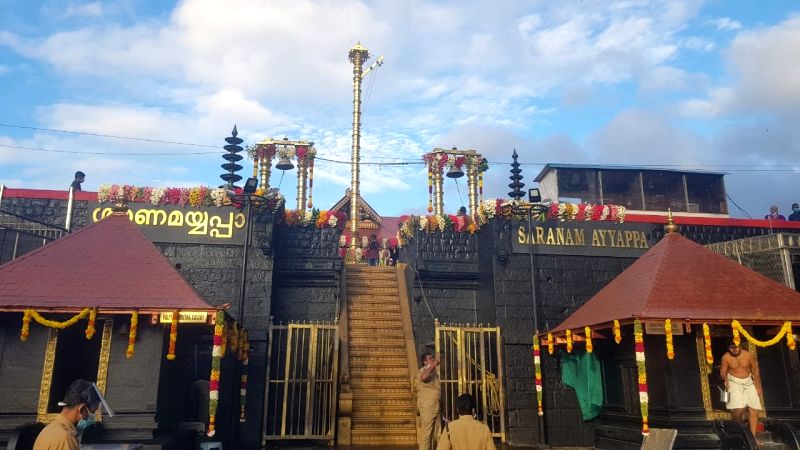Case Name: Indian Young Lawyers Association & Ors vs. The State of Kerala & Ors.
Citation: Writ Petition(Civil) No 373 of 2006
The Sabarimala Temple case, a historic court case over the admission of menstruation women onto the temple grounds, has spurred discussion on topics including gender equality, religious freedom, and constitutional interpretation. The case’s dissenting opinion by Justice Indu Malhotra provides a distinctive viewpoint on how custom, religious beliefs, and constitutional values interact.
This article offers a thorough study of Justice Malhotra’s and Justice DY Chandrachud’s opinions, looking at the constitutional precepts, historical background, and legal justifications for her stance. From Justice Malhotra’s & Justice DY Chandrachud’s dissenting perspective, this article attempts to clarify the intricacies and subtleties of the Sabarimala Temple case by examining pertinent laws, such as the Indian Constitution and court decisions.
Introduction:
The Sabarimala Temple case, which centred on the entry of women of menstruating age (10–50 years) into the temple premises, has emerged as a seminal legal and social issue in India. The Supreme Court’s verdict in 2018 allowing the entry of women into the temple sparked intense debate and controversy, with divergent views on the implications for religious freedom, tradition, and gender equality.

Subsequently, the court questioned the ban, stating that it was unconstitutional. The Keralan government supported allowing women to access the temple’s innermost chamber.
Women of all ages were permitted admission to the temple last year by a five-judge panel of the Supreme Court. Many followers continued to camp outside the temple even after this decision was made in order to bar women from entering.
The Supreme Court referred to the petitions asking for a review of the earlier ruling. This article provides insights into Justice Malhotra’s and Justice DY Chandrachud’s reasoning and arguments by exploring the legal complexities, constitutional concepts, and historical background that underlie their opposing opinions in the Sabarimala Temple case.
Background and context:
- Sabarimala Temple Issue –
- – Located in the forests of the Western Ghats in Kerala’s Pathanamthitta district, the hill shrine is dedicated to Lord Ayyappa and is managed by the Travancore Devaswom Board (TDB).
- The Sabarimala temple prohibits women aged between 10 and 50 years from entering the shrine. It is said that its deity, Lord Ayyappa, is a “Naisthik Brahmachari” and that allowing young women to enter the temple would affect the idol’s “celibacy” and “austerity”.
- The Travancore Devaswom Board has said that the prohibition on women of menstruating age from entering the temple is a part of the ‘essential religious practice’ of Lord Ayappa devotees.
- The petitioners have argued that the ban enforced on menstruating women from entering the Sabarimala shrine does not constitute a core foundation of the religion. 1/3 Preventing women’s entry to the temple with an irrational and obsolete notion of “purity” offends the equality clauses in the Constitution.
- It takes away the woman’s right against discrimination guaranteed under Article 15(1) of the Constitution. It also curtails the religious freedom assured by Article 25(1).
- In 1991, the Kerala High Court upheld the prohibition on young women’s entry into Sabarimala Shrine. The High Court had pointed out that the ‘Naisthik Brahmachari’ nature of the deity was “a vital reason for imposing this restriction on young women”.
- Litigation and Judicial Intervention:
- The entry ban on women of menstruating age was challenged before the Supreme Court on grounds of gender discrimination and violation of constitutional rights.
- In a historic judgement in September 2018, a five-judge bench of the Supreme Court, by a majority of 4:1, ruled in favor of allowing women’s entry into the Sabarimala Temple, overturning the traditional ban.
JUDGEMENT
Justice Indu Malhotra’s Dissenting Opinion:
- Preservation of Religious Practices:
- Justice Malhotra emphasised the importance of respecting religious practices and traditions as integral aspects of India’s cultural diversity.
- She cautioned against judicial interference in matters of religious belief and practice, advocating for a balanced approach that respects both religious freedoms and constitutional rights.
- Constitutional Principles:
- Justice Malhotra highlighted the constitutional guarantee of freedom of religion under Article 25 of the Constitution, which protects individuals’ rights to profess, practice, and propagate religion.
- She underscored the need to strike a delicate balance between religious freedoms and other constitutional rights, such as gender equality and non-discrimination.
Legal Analysis and Laws Used:
- Constitutional Provisions:
- Article 25: Freedom of conscience and free profession, practice, and propagation of religion.
- Article 26: Freedom to manage religious affairs.
- Article 15: Prohibition of discrimination on grounds of religion, race, caste, sex, or place of birth.
- Judicial Precedents:
- Sardar Syedna Tahir Saifuddin Saheb v. State of Bombay (1962): The Supreme Court upheld the right of the Dawoodi Bohra community to enforce its religious practices, emphasising the autonomy of religious denominations.
- Durgah Committee, Ajmer v. Syed Hussain Ali (1962): The Supreme Court affirmed the autonomy of religious institutions in managing their internal affairs, subject to constitutional limitations.
Dissenting Views of Justice DY Chandrachud
According to Justice DY Chandrachud’s ruling, denying women the freedom to practise their religion would be akin to subjugating them. He goes on to say that the practice of exclusion, which is based on “physiological factors” that are not religious and implies that women cannot keep the “vrutham” or participate in the pilgrimage, stigmatises and stereotypes them and is, thus, a kind of discrimination against them in society. According to Chandrachud, the rationale for their exclusion is unlawful because they menstruate. According to Justice Mishra, any regulation that discriminates against or diminishes the worth of women must be overturned since it violates Articles 14 and 15. The justices who made up the majority ruling viewed this exclusion of women as discriminatory under Article 25, which equally gave everyone the right to freely practise their faith, regardless of gender. The petitioners have also brought up “Article 17,” particularly the women’s NGO “Happy to Bleed.” Because women menstruate and are deemed impure during that time, they are prohibited from participating in religious activities by Article 17, which outlaws untouchability in all its forms. This discriminatory practice is on par with the exclusion of oppressed castes as untouchables. The justices’ stance emphasises that the Constitution shouldn’t be used as a tool to support patriarchy and expands the scope of Article 17.
Sabarimala 2019 Review Petition
In 2018, the Supreme Court ruled that any woman, regardless of age, might enter the Sabarimala shrine. A greater portion of the public was incensed by the ruling since it interfered with their long-standing religious beliefs and sentiments. Due to the disturbance caused by the judgement, which was not well received by the right-wing and religiously devoted male population, they filed court review applications.

The primary point of dispute in the petition, which was submitted in opposition to the Supreme Court’s 2018 ruling, was whether or not the court had the authority to interpret and get involved in questions of religion and faith. Petitioners argued that the devotion in the temple is based on the celibate character of the deity. Constitutional morality is not to be used to understand faith; it is merely a subjective standard. It has an impact on their freedom to independently practise their religion. The 2018 ruling introduced the concept of untouchability, which was deemed incorrect since it was applied to the situation without sufficient thought or study.
The court therefore made the decision to postpone the review petitions and to uphold the 2018 order that permitted women to enter the temple until a larger bench could decide the matter. While women’s access to the Sabarimala temple is unrestricted, this ruling will also have an impact on other related issues. Therefore, it is best to refrain from delivering any judgment on it as of now. The court expressed dissatisfaction with how individuals responded and did not applaud the ruling. Instead of adhering to it, many became upset and rejected it entirely because of how it compromised the honour of the Supreme Court. The Supreme Court was established by our Constitution to protect and safeguard itself, and it is our duty to respect its dignity. Accordingly, the court held that while citizens have the right to file a review if they are unhappy with the court’s decision, they also have an obligation to follow and obey the rules that the court establishes.
Conclusion
This ruling is historic, particularly in light of the nation’s current religious divisions. In India, religion has a significant influence on how society is shaped. The ruling is progressive and demonstrates that the values of constitutional morality would never be compromised by orthodoxy, superstition, or patriarchy.
The court upheld the same premise and did not take away the rights granted to women in the 2018 verdict, even though it promised to consider other concerns related to the petitions in the future. Thus, the Supreme Court has demonstrated that morality and equality at their core are more important than any other ideal and will always be preserved.
Adv. Khanak Sharma

